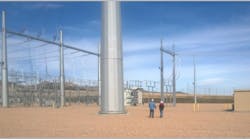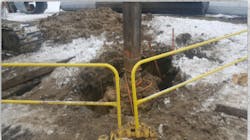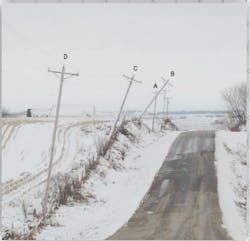Power Line Foundations and Substation Footprints: Expect the Worst, Design for the Actual
Let’s get one thing clear from the start about power lines and substations: they are often located in less than ideal locations when it comes to soils. It isn’t uncommon for a designer to be confronted by a piece of swamp land designated for a substation or pole location.
To be fair, the location of a substation has many other requirements besides soil suitability. However, when it comes to substation design, it can pay off to consider constructability of the foundations. Most of the problems will arise from below the surface. Substations, while often placed on poor soils because of land prices availability, and location of electric lines, face less soil variability than transmission and distribution lines. Designers first want to determine the general arrangement of the substation so that they can pinpoint the locations of major equipment such as control houses, transformers, breakers and large dead-end structures. This allows them to fine tune their geotechnical drilling program.
Transmission foundations, their larger cousins, are not much better off. Transmission projects are linear in nature, thus leading to higher variability of soil characteristics. Transmission foundations are large investments, often more expensive than the steel monopole structures they support when considering labor costs. They also provide the highest probability for contract overruns and change orders because of unforeseen conditions, poor soils, groundwater, or underground obstructions, which can cause construction delays or worse — reroutes. Every transmission line foundation represents a separate and unique construction project, full of challenges.
On rural high voltage projects, it is the rule of thumb of some to take a soil boring every mile for tangent structures and at every dead-end and heavy running angle structure. The number of soil borings is sometimes capped because of budgetary concerns. The reality? Taking too few soil borings can be much more damaging to the project budget. Why? Because engineers must be conservative in their designs to protect the public and keep their licenses intact.
For example, let’s assume that for the same rural transmission line, monopole structures have a typical spacing of 900 ft. This assumption yields approximately seven structures (six spans) per mile. In this example, there is roughly one mile between dead-ends, one located in great soil, one in poor soil, with five tangent structures in between. Using the “one boring per mile plus dead-ends rule,” no soil borings are taken at any of the five tangent structure locations between the two dead-ends. Being conservative, the foundation engineer must assume the worst case for six out of the seven foundations in that given mile of transmission line, resulting in potentially over-designed foundations or under-designed foundations.
If you assume typical material and construction costs for the installation of an eight-foot diameter drilled pier, each additional foot can cost an owner over US$1,000 per vertical foot of drilled pier. Let’s take it one step further and assume that because of the poor soil assumption, the design requires an additional 10 ft of drilled pier per structure. In the end, this assumption and the decision not to drill any additional borings within the one mile could result in a US$60,000 difference in total foundation costs.
Distribution poles
Distribution pole foundations are the most often overlooked and standardized, making them most susceptible to settlement, deflection and eventual failure. Because of their minimal cost and a less critical nature than their transmission counterparts, some prefer to repair a leaning or failing distribution pole than to properly design it for actual soil conditions.
Today’s conductors are larger than ever, and distribution structures are expected to accommodate additional joint-use or under-built cables. As such, it is recommended that engineers emphasize geotechnical investigation as much as transmission construction. It will pay off in the form of longer line lifespans and reduced maintenance costs and line outages.
Another commonly overlooked item to consider when determining distribution pole embedment is the proximity of slopes in the terrain. Adjacent slopes are responsible for a reduction in lateral resistance, thus limiting the lateral capacity of the foundation. Foundations of structures susceptible to loading in the direction of a slope, as in the case of a ditch or embankment, need soil assessments and adjustment for slope correction. The traditional “10% + 2 ft” standard for pole embedment is inadequate for today’s uses. Finally, distribution pole foundations need to be evaluated for slope correction and for using bog shoes or swamp fixtures in watery areas.
Foundation selection considerations
Even after a proper geotechnical analysis, engineers must still determine which type of foundation makes the most sense. Below are six factors commonly considered when determining foundation type in power delivery projects:
- Cost – Cost is always a major consideration. Rocky soils, for example, can spike foundation costs dramatically. Also, if a wetland can be averted, it can save tens of thousands in permitting expenses as well as additional costs because of soft or organic soils.
- Schedule and outage constraints – Depending on whether the project is a rebuild or a greenfield, outages may need to be scheduled during construction and that could affect the project schedule. Certain types of foundations are quicker to install than others.
- Material/equipment availability and procurement – Material availability and proximity to the project is important. Can the material vendor supply the materials on time? Can the contractor get the necessary equipment to the site on time? These questions need to be asked.
- Hauling restrictions – Road weight limits, frost laws, ingress and egress, and other logistical issues all apply. If axle weight is an issue, concrete trucks may not be the best option.
- Access requirements – Permissions must be obtained from private landowners, and local traffic restrictions may be present. If an access route exists, the physical condition of the access road can also play a role in the decision. If an access must be created, the construction and permitting costs can add up.
- Maintenance requirements – The design should consider maintenance accessibility. For example, remote or flood-prone areas may prevent routine maintenance or may require aerial inspection.
Conclusion
Foundation considerations for transmission lines, distribution lines and substations must begin early in the project. Within reason, all structure locations should be drilled and tested to discover conditions that will affect the designs. The more information, the better. Discovering poor soils, rock, or unknown obstacles during construction will result in a project that is over budget and behind schedule.




